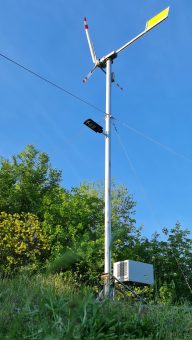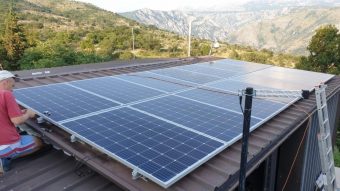
The flexibility of renewable energy sources RESD facilitates global energy transition. So solar panels are installed on vast roofs of big companies and on small roofs of houses and buildings, while wind turbines turn day and night at the hills and offshore. Still, this is not a story about gigantic projects in the RES sector that can supply the whole companies or even towns. Instead, we want to introduce a man who has shown us that everything becomes possible with a little help of imagination, a lot of skills, and strong faith in a greener future.
It’s not all about the money. There is something in the waste.
The key to success in life is love for what you do. Ever since he was in high school in his birthplace Podgorica, Vladimir Tošković has developed a great interest in electronics, and the mandatory courses soon became a hobby. However, out of the prosperous career that Tošković has, wind generator stands out, which he designed and made from, surprisingly enough, waste.
“Frequent power cuts and deteriorated distribution network are the main reason for the beginning of this little endeavor in my village Bratnožići. I wanted to provide constant supply and better conditions for living in the country”, Tošković starts his story about this uncommon enterprise.
When persistence and skills join together, construction material is the slightest problem. For constructing wind generator, Vladimir used everything that he got his hands on: waste iron, bearings with truck axis, metal profiles and pipes, alternator, and later even a high voltage generator with ceramic magnets that are temperature resistant.
“My goal was to make a construction that will last and be resilient to strong wind blows which are prevailing in these areas, but with minimal maintenance. Therefore, certain adjustments (tearing, welding and soldering) and concreting of strong foundation and girders for an axis of wind generator which was adjusted to easy mounting and dismounting, were all inevitable”, Vladimir explains.
In focus:
He adds jokingly that the villagers were watching him in amazement while working on his invention, asking him what that scrap heap is. His effort soon paid off, and the wind generator brought 2 kW of free energy. However, the best way to furnish the most considerable profit and constant electricity supply is to provide several renewable energy sources. There is no mistaking with a hybrid system, explains Vladimir, and the combination of solar panels and wind generator has proved to be a winning formula. Therefore, apart from the wind generator, solar panels generate an additional 4 kW of electricity at his estate.
Hybrid systems for stable electricity supply

Hybrid systems for stable electricity supply In layman’s terms, nature offers energy free of charge. Therefore, it is up to us to use natural resources wisely to provide enough energy for our needs and safeguard the environment for the generation to come.
He didn’t want his children to grow up in a world contaminated with exhaust fumes, so he decided to show by an example the best way to generate green energy.
“Hybrid systems offer a higher efficiency level as they don’t depend on weather conditions that affect the system supplying exclusively from one renewable source. Instead, several available sources might be included such as the energy of sun, wind, tides, and waves, as well as geothermal energy, where we the green electricity is generated in this hybrid kind of connection”, Tošković explains the advantages of the hybrid systems.
His choice is the off-grid system which accumulates electricity in batteries, in contrast to the on-grid system that has to be connected to the grid. The required equipment for off-grid systems includes batteries and inverter so that direct voltage of the batteries, with accumulated energy received from solar panels and wind generators, can be transformed into alternating voltage for households. Conversion reduces heat losses and increases efficiency by converting the voltage for the inverter’s operation.
Prepared by: Milena Maglovski
Read the story in the new issue of the Energy portal Magazine WATER RESOURCES.



